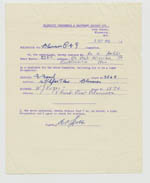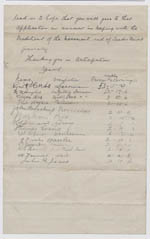|
Co-operative Principles | Members |
Committee | Staff |
Co-operation |
Other types of Co-operative |
Consolidation Co-operative Principles
Over time the original principles established by the Rochdale Pioneers have
been developed in line with the evolution of the Co-operative Movement. In
1937, 1966 and 1995 the International Co-operative Alliance undertook
reviews of the Principles to ensure that they were relevant and up-to-date.
Rochdale Principles
• Open Membership
• Democratic Control
• Distribution of Surplus in Proportion to Trade
• Payment of Limited Interest on Capital
• Political and Religious Neutrality
• Cash Trading
• Promotion of Education
International Co-operative Alliance: Principles
• Voluntary and Open Membership
• Democratic Member Control
• Member Economic Participation
• Autonomy and Independence
• Education, Training and Information
• Co-operation among Co-operatives
• Concern for Community
Suggested further reading:
• International Co-operative Alliance -
http://www.ica.coop/coop/principles.html
Members
Individual members have a great importance within co-operative societies.
All members have an equal vote on matters (one member, one vote), and
without the active participation there is the risk that societies fall into
decline.

This advertisement by Mid-Rhondda Co-operative Society for new
members indicates the importance of encouraging people to join their local
co-operative society in order for the movement to flourish and for people to
reap the rewards. [SWCC/MND/137/2/41/3]
Committee
Co-operative societies were initially local autonomous organisations,
managed by committee. Any eligible member could stand for office and the
elected committee was responsible to the membership.

Although societies had their own rules, the board of management
was often around ten in number, one of whom would also be President. Members
were called upon to elect the board from those who were eligible and put
themselves forward, such as Mr WA Hobbs, who stood for the committee of
Blaenavon Co-operative Society in 1955. [SWCC/MND/137/2/9/27]
Staff
In contrast to private businesses the conditions for staff working for
co-operative societies were often preferable, with terms and conditions
improving over time. Wages and bonuses, the length of the working week,
annual holiday, paid sick leave, employment prospects and membership of a
trade union were matters debated between employees and employers, and the
Co-operative Societies were often the first to offer improved terms and
conditions.


This letter to the Committee of the Treorchy Co-operative Society
from the male employees highlights some of the issues concerning the staff
of co-operative stores, in particular wages. The difference between female
and male workers is stressed, and the place of trade unions within the
co-operative movement is also expressed. [SWCC/MND/137/2/69/11]
Co-operation
Co-operation between co-operatives was important and was seen as a way of
strengthening the movement and making it more efficient. This could involve
consumer co-operatives purchasing from productive co-operative societies,
such as the Rhondda Co-operative Productive Butchery Society or the
Co-operative Wholesale Society. However, it may simply be an instance of
aiding a neighbouring society in need of assistance, such as that offered by
Ton Industrial Co-operative Society to Treorchy Co-operative Society when
its bakery broke down.

This letter of thanks to Ton Co-operative Society from Treorchy
Co-operative Society for their assistance following the breakdown of the
bakery, shortly after bread rationing was introduced, illustrates
‘co-operation in its fullest sense’, whereby people willingly act together
for a common purpose good. [SWCC/MND/137/2/70/9]
Suggested further reading:
• International Co-operative Alliance -
http://www.ica.coop/al-ica/
Other types of Co-operative
In addition to the well-known co-op stores, which are types of consumer
co-operatives, there were other Co-operative Societies and organisations.
Federations between co-operatives were one way in which some co-operatives
developed. For example, Ton, Penygraig and Mid-Rhondda Co-operative
Societies formed a joint butchery service, the Rhondda Co-operative Butchery
Productive Society. Agricultural co-operation was another development, and
in Wales this was lead by the Welsh Agricultural Organisation Society
(WAOS). The WAOS promoted co-operative initiatives, and acted as an adviser
on agricultural, horticultural and business matters. Workers’ co-operatives
are another type of co-operative, with, perhaps, the best known modern one
in Wales being Tower Colliery, which was in operation between 1995 and 2008.

Rules of the Rhondda Co-operative Butchery Productive Society Limited, 1921.
[SWCC/MND/137/2/61/1]
Consolidation
The late nineteenth and early twentieth centuries saw a rapid growth in the
number of co-operative societies in South Wales, as well as elsewhere. Where
societies failed within a short period of time, it was often the case that
another attempt would be made, such as at Swansea. When agreement could be
reached societies would amalgamate with neighbours, such as Cwmbach,
Aberdare and Trecynon Co-operative Societies becoming the Aberdare and
District Co-operative Society, ensuring the survival of a co-operative
presence in an area. The decline in the number of individual co-operative
societies was at times matched by an increase in the number of members.
There was also a development in the way retail co-operation was organised
across Britain. For example, in 1936 the Cardiff Co-operative Society became
part of the Co-operative Wholesale Society, thereby uniting distributive and
consumer co-operatives.

Ynysybwl Co-operative Society grew considerably and established
several branches within the district, including an arcade of stores at
Pontypridd. As well as establishing branches Ynysybwl Co-operative Society
also took over neighbouring societies, including Llantwit Fardre
Co-operative Society in 1918 and Senghenydd and Aber Valley Co-operative
Society during World War II. [SWCC/MND/137/2/73/2]
|
|













